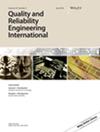对粉末涡轮盘初始缺陷导致的疲劳裂纹增长进行基于区域的失效风险评估
IF 2.8
3区 工程技术
Q3 ENGINEERING, INDUSTRIAL
引用次数: 0
摘要
本研究针对 FGH96 合金涡轮盘初始缺陷引起的疲劳裂纹增长(FCG),开发了一种基于区域的失效风险评估(FRA)方法。首先,根据缺陷数据计算 FGH96 合金涡轮盘的初始缺陷分布。随后,考虑到晶粒尺寸的分散性,建立了短FCG寿命概率模型。同时,结合寿命分散因素,建立了FCG长寿命概率模型。为了计算圆盘任意位置的应力强度因子(SIF),建立了一般权重函数法和矩形板模型。最后,建立了分区过程,使 FRA 能够考虑初始缺陷导致的 FCG。结果表明,对应于涡轮盘 0.13% 故障概率的循环次数为 7150 次,并分析了每个区域的故障百分比。本文章由计算机程序翻译,如有差异,请以英文原文为准。
Zone‐based failure risk assessment of fatigue crack growth caused by initial defects in powder turbine disc
In this research, A zone‐based failure risk assessment (FRA) method of fatigue crack growth (FCG) caused by initial defects in the FGH96 alloy turbine disc is developed. Firstly, the initial defects distribution in the FGH96 alloy turbine disc is calculated based on the defect data. Subsequently, a probabilistic short FCG life model is established, taking into account the dispersion in grain size. Meanwhile, a probabilistic long FCG life model is established, incorporating the life dispersion factor. To calculate the Stress Intensity Factor (SIF) at any position of the disc, the general weight function method and the rectangular plate model are established. Finally, the zoning process is established, enabling a FRA that considers the FCG due to initial defects. The results indicate that the number of cycles corresponding to a 0.13% failure probability of the turbine disc is 7150, and the percentage of failures in each zone is analyzed.
求助全文
通过发布文献求助,成功后即可免费获取论文全文。
去求助
来源期刊
CiteScore
4.90
自引率
21.70%
发文量
181
审稿时长
6 months
期刊介绍:
Quality and Reliability Engineering International is a journal devoted to practical engineering aspects of quality and reliability. A refereed technical journal published eight times per year, it covers the development and practical application of existing theoretical methods, research and industrial practices. Articles in the journal will be concerned with case studies, tutorial-type reviews and also with applications of new or well-known theory to the solution of actual quality and reliability problems in engineering.
Papers describing the use of mathematical and statistical tools to solve real life industrial problems are encouraged, provided that the emphasis is placed on practical applications and demonstrated case studies.
The scope of the journal is intended to include components, physics of failure, equipment and systems from the fields of electronic, electrical, mechanical and systems engineering. The areas of communications, aerospace, automotive, railways, shipboard equipment, control engineering and consumer products are all covered by the journal.
Quality and reliability of hardware as well as software are covered. Papers on software engineering and its impact on product quality and reliability are encouraged. The journal will also cover the management of quality and reliability in the engineering industry.
Special issues on a variety of key topics are published every year and contribute to the enhancement of Quality and Reliability Engineering International as a major reference in its field.

 求助内容:
求助内容: 应助结果提醒方式:
应助结果提醒方式:


